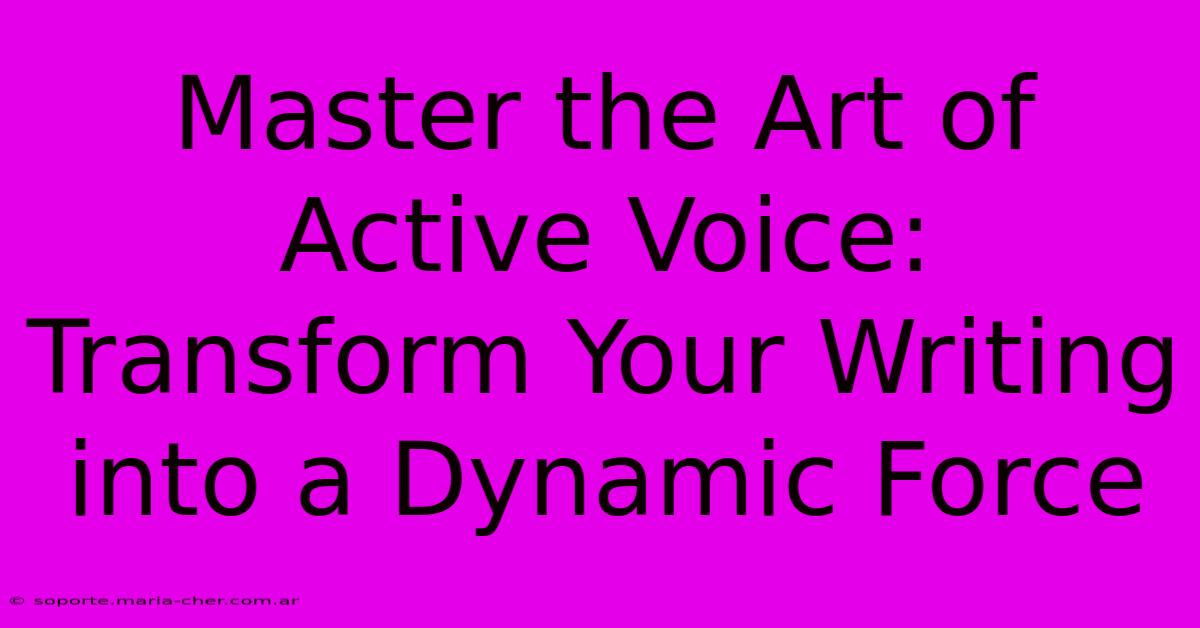Master The Art Of Active Voice: Transform Your Writing Into A Dynamic Force

Table of Contents
Master the Art of Active Voice: Transform Your Writing into a Dynamic Force
Are you ready to elevate your writing from mundane to magnificent? The key might be simpler than you think: mastering the art of active voice. Active voice breathes life into your prose, making it clearer, more concise, and far more engaging for your readers. This comprehensive guide will equip you with the knowledge and techniques to transform your writing into a dynamic force.
What is Active Voice?
In active voice, the subject of the sentence performs the action. The structure is straightforward: Subject + Verb + Object. For example:
- Active: The cat chased the mouse.
In this sentence, "cat" (subject) performs the action of "chasing" (verb) the "mouse" (object). Clear, concise, and easy to understand.
The Passive Voice Problem
Passive voice, conversely, reverses this structure. The action is performed on the subject, often obscuring who or what is responsible. The passive voice typically uses a form of the verb "to be" (is, are, was, were, etc.) plus a past participle.
- Passive: The mouse was chased by the cat.
While grammatically correct, the passive voice is often weaker and less impactful. It can lead to wordiness, ambiguity, and a less engaging reading experience. Overuse of passive voice can make your writing feel dull and impersonal.
When to (Occasionally) Use Passive Voice
While active voice reigns supreme in most writing, there are specific scenarios where passive voice can be appropriate:
- When the actor is unknown: "The window was broken."
- When the actor is unimportant: "The report was submitted on time."
- To emphasize the action, not the actor: "The patient was carefully monitored."
- To maintain objectivity in scientific or technical writing: "The experiment was conducted under controlled conditions."
However, even in these situations, carefully consider if active voice might be a stronger alternative.
Transforming Passive Voice into Active Voice: A Step-by-Step Guide
Converting passive sentences into active ones involves identifying the actor (the one performing the action) and placing it at the beginning of the sentence. Here's a simple process:
- Identify the verb: Find the verb in the passive sentence.
- Find the subject: The subject is usually receiving the action.
- Find the actor: This is the entity performing the action (often found after "by").
- Rewrite the sentence: Place the actor as the subject, use the active verb form, and add the object (if necessary).
Example:
- Passive: The project was completed by the team.
- Active: The team completed the project.
Benefits of Using Active Voice
Employing active voice consistently offers numerous advantages:
- Clarity and Conciseness: Active voice sentences are typically shorter and easier to understand.
- Stronger Impact: Active voice makes your writing more direct, forceful, and engaging.
- Improved Readability: Readers easily follow the flow of active voice sentences, leading to a more pleasant reading experience.
- Enhanced Professionalism: Consistent use of active voice reflects professionalism and attention to detail.
Mastering Active Voice: Practice Makes Perfect
The key to mastering active voice is practice. Review your writing, consciously identifying and correcting instances of passive voice. Read widely and pay attention to how skilled writers employ active voice to create compelling narratives and persuasive arguments. With consistent effort, you'll transform your writing style and elevate your communication skills to new heights.
Beyond Grammar: Style and Tone
While mastering active voice is crucial, remember that writing style and tone are equally important. Active voice shouldn't come at the cost of natural flow and reader engagement. Use active voice strategically to create impact, while maintaining a consistent and appropriate tone for your target audience and purpose.
By embracing the power of active voice, you'll not only improve your grammar but also significantly enhance the overall quality and impact of your writing. So, go forth and write with dynamism and clarity!

Thank you for visiting our website wich cover about Master The Art Of Active Voice: Transform Your Writing Into A Dynamic Force. We hope the information provided has been useful to you. Feel free to contact us if you have any questions or need further assistance. See you next time and dont miss to bookmark.
Featured Posts
-
Centrestage Stunners 6 Unforgettable Floral Arrangements For Wedding Tables
Feb 08, 2025
-
Vegetables On Fire The Ultimate Guide To Blackened Greens For The Grill
Feb 08, 2025
-
Blooming On A Budget Lily Of The Valley Bouquets That Wont Break The Bank
Feb 08, 2025
-
Polaroid Picture Puzzle Whats The True Size Of Your Memories
Feb 08, 2025
-
Abstract Expressionism In Photography Patterns That Paint A Thousand Words
Feb 08, 2025
